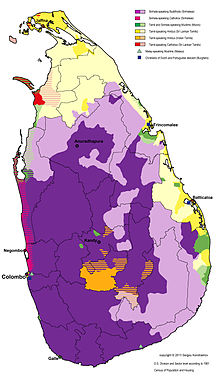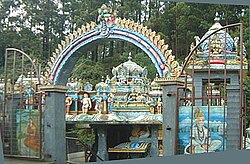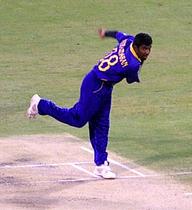Indian Tamils of Sri Lanka
மலையகத் தமிழர் ශ්රී ලංකාවේ ඉන්දියානු දෙමළ ජනතාව | |
|---|---|
 Indian Tamil woman working in a tea plantation in central Sri Lanka | |
| Total population | |
| 842,323[1] (4.2% of the Sri Lankan population) (2012)[2] | |
| Regions with significant populations | |
| Province | |
| 484,429 | |
| 154,252 | |
| 104,063 | |
| 61,826 | |
| Languages | |
| Tamil (L1) Sinhala (L2) | |
| Religion | |
| Majority Hinduism Minority | |
| Related ethnic groups | |
Indian Tamils of Sri Lanka are Tamil people of Indian origin in Sri Lanka. They are also known as Malayaga Tamilar, Hill Country Tamils, Up-Country Tamils or simply Indian Tamils. They predominantly descend from workers sent from
The Tamils in Sri Lanka can be divided into two groups, the
Sri Lankan Tamils mostly live in the Northern and Eastern Provinces and in the capital of Colombo, whereas Hill Country Tamils largely live in the central highlands.[7] The Hill Country Tamils and Ceylon Tamils historically have seen themselves as separate communities, particularly due to the nativity of the island, and due to caste level differences as well.[8] In 1949, the United National Party (UNP) government stripped the Indian Tamils of their nationality, including their right to vote. Prominent Tamil political leaders such as S. J. V. Chelvanayakam and his Tamil opposition party opposed this move.[9]
Under an agreement between the Sri Lankan and Indian governments in the 1960s, around 40% of Hill Country Tamils were granted Sri Lankan nationality and many of the remainder were repatriated to India.
History
Initial recruitment

The Hill Country Tamils derive their origins from a
Community development

The community was a closed community confining themselves to the plantations, while actively contributed and contributes to the economic well-being of Sri Lanka but the socio-economic indicators of the community was among the worst in the country. The community in general was isolated, living in ghettos within the central region as well as linguistically isolated from the majority Sinhalese villagers who live in the valleys. They were captive labour whose life in its entirety was decided by their employers. Any social relationships or cultural ties were only among themselves or with South India. In the 1940s the trade union movement had galvanized the plantation workers into a militant working class. They joined hands with the Lanka Sama Samaja (or Trotskyist) Party, which carried the message of a working-class struggle for liberation from the exploitation by the mainly-British plantation companies.
Sri Lanka became independent in 1948 and the community believes that it became the first community marked out for discrimination by the new state of Ceylon in 1948. In the
Disenfranchisement
The first
Donoughmore Commission
The Donoughmore Commission of 1928 recommended universal franchise, and this was also meant to include the plantation workers as well. Page 57 of the report proposed:
In the first place we consider it very desirable that a qualification of five years residence in the Island (allowing the temporary absence not exceeding eight months in all during the five years period) should be introduced in order that the privilege of voting should be confined to those who have an abiding interest in the country or who may be regarded as permanently settled in the Island... this condition will be of particular importance in its application to the Indian immigrant population. Secondly, we consider that the registration of voters should not be compulsory or automatic but should be restricted to those who apply for it.
However, the very concept of universal franchise was anathema to most of the political leaders of that era. Ponnambalam Ramanathan, a highly respected leader, opposed universal franchise as he felt that the caste system was an integral part of the Hindu way of life,[17] and led a delegation to London seeking to legally enshrine the caste hierarchy, and dethrone universal franchise. The Kandyan Sinhalese also objected to the enfranchisement of the Indian estate workers as they feared that their electoral base would be diluted by a large influx of Indian Tamil votes. They also argued that the tea estates were built on land confiscated by the British colonial government, and that the Kandyan peasants had been driven from their traditional lands and those injustices would be compounded if the Indian workers were legitimized. Governor Stanley, by an order in council introduced restrictions on the citizenship of Indian workers to make the Donoughmore proposals acceptable to the Ceylonese leaders. Thus the first state council of 1931, which consisted of many Tamil and Sinhalese members, agreed to not to enfranchise the majority of the Indian estate workers.[17]: 36
Soulbury Commission
A decade later, the Soulbury Commission, which paved the way for the independence of Ceylon recognized the "anxieties arising out of the likelihood of large-scale enfranchisement of the Indian immigrants", The Commission, therefore, left the existing basis of franchise in Sri Lanka undisturbed.[18] D. S. Senanayake had led the 1941 talks with Sir G. S. Bajpai of India and had reached agreement on modalities of repatriation and citizenship, although they were finally not ratified by Indian Prime Minister Jawaharlal Nehru. D. S. Senanayake had expressed the wish to "embrace all Indian workers who integrate into the country as members of the Ceylonese nation", and had been relatively sympathetic, as early as 1928, and as late as 1941, to the granting of citizenship to Indian workers who wished to become permanent residents of the island.
The Soulbury constitution came into effect in 1946. In trying to cobble an all-party cabinet inclusive of the Tamils, led by
Parliamentary acts
As the first
Opposition views
However, Ponnambalam and Senanayake were strongly criticized by the Marxist groups as well as by the pro-Sri Lankan Tamil
Final rectification
The

The
Society
Demographics
| Year | Pop. | ±% |
|---|---|---|
| 1911 | 531,000 | — |
| 1921 | 602,700 | +13.5% |
| 1931 | 818,500 | +35.8% |
| 1946 | 780,600 | −4.6% |
| 1953 | 974,100 | +24.8% |
| 1963 | 1,123,000 | +15.3% |
| 1971 | 1,174,900 | +4.6% |
| 1981 | 818,700 | −30.3% |
| 1989 (est.) | 873,000 | +6.6% |
| 2001 | 855,000 | −2.1% |
| 2011 | 842,323 | −1.5% |
| Source: Sri Lankan Government Census. | ||
Census operations started in Sri Lanka in 1871. The Census of 1871, 1881, 1891 and 1901 had lumped together Sri Lankan Tamils and Indian Tamils. Since 1911, Indian Tamils have been shown as a separate category. The population statistics are revealing. In 1911, Indian Tamils constituted 12.9 per cent of the population, whereas Sri Lankan Tamils formed 12.8 per cent; in 1921, 13.4 per cent and 11.5 per cent; in 1931, 15.2 and 11.3; in 1946, 11.7 and 11.0; in 1953, 12.0 and 10.9; in 1963, 10.6 and 11.0; in 1971, 11.6 and 11.2; and in 1981, 5.5 per cent and 12.7 per cent respectively.[11]
The statistics reveal a more than 50 per cent fall in the Indian Tamil population between 1971 and 1981. The main reason for the fall was the repatriation of Indian citizens to India. Another fact is that many Indian Tamils, after acquiring Sri Lankan citizenship, declared themselves as Sri Lankan Tamils. Some Tamils who migrated to urban areas and also to the north and the east also followed this same example.[11]
Language

Indian Tamils of Sri Lanka predominantly speak Tamil, however depending on where they live in the country, they may also additionally speak Sinhala and or English. According to the 2012 Census 61.5% or 412,685 Indian Tamils of Sri Lanka also spoke Sinhala and 13.0% or 87,435 Indian Tamils of Sri Lanka also spoke English.[23]
Social structure

The social structure of the plantations resembles the South Indian rural social structure. The community is generally bound by the caste system. In a plantation, the tea factory is the centre of activities and it stands in the central part of the plantation. The office adjoins this and these are surrounded by the quarters of the staff members such as clerks, tea makers, conductors, petty accountants or kanakkupillais, and supervisors. The bungalows of the planter and his assistants are in an isolated areas. These will be in close proximity to the office. The dwellings of the workers called line rooms are situated a little further away from the factories.[14]
Those who are considered to be of higher castes occupy the first row of line rooms. They perform respectable jobs such as factory work and grinding of tea as minor labour work. Even though they belong to the labour category they are influential among conductors, tea makers, kanganies (or supervisors) and other officials. The workers considered low caste live in the dwellings that are away from the centre and these dwellings are called distant or lower lines. This group consists of
Customs
These groups follow the customs, traditions, and festivities of their South Indian Tamil
Religion

In general they use
In 1981 about 90 percent of the Indian Tamils were Hindus.
The first known temple was built in Matale. It began as a stone an icon of the goddess
Folk deities
Each caste has its own deity based on caste predecessors and are worshipped as guardian angels, such as the
Temple societies
There were 104 registered Hindu temples in the Nuwara Eliya District, 153 in Kandy region and 62 in Matale in 2001. Religious schools or araa nerri padasaligal are conducted throughout the Central Province and registered schools of such nature are, Nuwara Eliya 22, Kandy 54 and Matale 11. A considerable number of Hindu associations and institutions have been established and are functioning actively. There is a serious effort at conversions to other religions as well. Many have converted to Christianity and Islam. Hindu organizations such as the Vishva Hindu Parishad try to stem the tide of conversions.[14]
Labour practices

Based on the cultivation of cash crops, labour is the dominant sector in the country's economy. It is a major earner of foreign exchange and the largest employer. Cheap labour is one of the essential ingredients of its success. Hence these immigrants were bonded and underpaid. In 1921 workers were empowered to break these bonds of indebtedness tying them to the estates. The minimum wages ordinance was extended to plantation labour in 1927 marginally raising the wages that had not changed since the 19th century. This daily wages was 41 Cts. in 1933. Owing to trade union activities it was raised to Rs 17/83 in 1983, Rs 72/24 in 1993 and became Rs 101 in 1998. The wages of female workers was less than males but has been equalized since 1984. Even though there was an increase in wages, the living wages are not sufficient to meet their day-to-day needs. The plantations were nationalized under the 1972 land reform law and its 1975 amendment. The state owned plantations are managed by the Sri Lanka Plantation Corporation and the Janatha Estate Development Board. The nationalization did not result in any basic change on the plantation sector. The state has been forced to take a greater interest in the health, housing and general well-being of the labourers. Hence estate schools were nationalized and brought into the general educational system. With the grant of the
Prominent people

- wickets taken in both Test cricket and ODI's
- Savumiamoorthy Thondaman – Post-independence politician
- Mano Ganesan – Prominent human rights activist, trade unionist and politician
- Arumugan Thondaman– Sri Lankan politician
See also
- Sri Lankan Tamils in India
- Colombo Chetties
- Bharatakula
- South Indian Immigration towards Sri Lanka
References
- ^ "A2 : Population by ethnic group according to districts, 2012". Census of Population & Housing, 2011. Department of Census & Statistics, Sri Lanka. Archived from the original on 2017-04-28. Retrieved 2012-10-23.
- ^ "The World Factbook — Central Intelligence Agency". Cia.gov. Retrieved 17 August 2018.
- ^ http://ijariie.com/AdminUploadPdf/Caste_Systems_Exercising_By_Tamil_Community_in_Sri_Lanka_ijariie12021.pdf [bare URL PDF]
- ^ https://files.institutesi.org/Hill_Country_Tamils_Of_Sri_Lanka_Report.pdf [bare URL PDF]
- ^ "A subset of Tamils lags other Sri Lankans by almost every measure". The Economist. 30 September 2017.
- ^ de Silva, C.R. Sri Lanka – A History, pp.177, 181.
- ^ "Statistics Sri Lanka, Population by district and ethnicity" (PDF). Statistics Sri Lanka. Archived from the original (PDF) on 2017-07-13. Retrieved 2008-02-21.
- ^ Hill Country Tamils Of Sri Lanka Towards Meaningful Citizenship (PDF). Sri Lanka: Verité Research. 2019. p. 33.
- ^ Rajan Hoole. "Missed Opportunities and the Loss of Democracy:The Disfranchisement of Indian Tamils: 1948–49". Uthr.org. Retrieved 2007-05-03.
- ^ a b de Silva, C.R. Sri Lanka – A History, p.262
- ^ a b c d e "In search of a new identity". V. Suryanarayan. Archived from the original on 2008-05-29. Retrieved 2008-03-05.
- ISBN 978-1-136-63997-5.
- ^ Nadarajan, V History of Ceylon Tamils, p.124
- ^ a b c d e f g h i j k l m Radhakrishnan, V. "Indian origin in Sri Lanka:Their plight and struggle for survival". Proceedings of First International Conference & Gathering of Elders. International Center for Cultural Studies, USA. Archived from the original on 2008-03-20. Retrieved 2008-01-23.
- ^ "Sri Lanka – an Overview". Fulbright Commission. Archived from the original on 2008-03-05. Retrieved 2008-02-20.
- ^ "A promise of identity". V. S Sambandan. Archived from the original on March 26, 2005. Retrieved 2008-02-05.
{{cite web}}: CS1 maint: unfit URL (link) - ^ a b Dr. Jane Russell, Communal Politics under the Donoughmore Commission, 1931–1947, Tissera Publishers, Sri Lanka 1982
- ^ H. Chattopadhyaya, Indians in Sri Lanka, 1979, p. 217
- ^ a b Prof. K. M. de Silva, History of Sri Lanka, Penguin, 1995, p. 539
- ^ B.K.Jain, "The Problem of Citizenship Rights of Persons of Indian Origin in Ceylon", Indian Journal of Political Science Vol.24, No. 1, 1963; J.S.Bains, "India's International Disputes", 1962.
- ^ "Plight of repatriated Hill Country Tamils in India". Refugee International. Archived from the original on 2008-02-19. Retrieved 2008-02-20.
- ^ "Population by ethnic group, census years" (PDF). Department of Census & Statistics, Sri Lanka. Archived from the original (PDF) on 13 November 2011. Retrieved 23 October 2012.
- ^ "Census of Population and Housing 2011". www.statistics.gov.lk. Department of Census and Statistics. Archived from the original on 16 April 2021. Retrieved 14 November 2018.
- ^ a b "Sri Lanka:Country study". Russell Ross. Retrieved 2008-03-05.
- ^ "Indian Tamils and Plantation economy of Sri Lanka". Noel S Nadesan. Retrieved 2008-02-20.
Further reading
- de Silva, C.R. (1987, 2nd ed. 1997). Sri Lanka – A History, New Delhi, Vikas Publishing House. ISBN 81-259-0461-1
- de Silva, K. M. (2005). A History of Sri Lanka. ISBN 955-8095-92-3.
- Ross, Russell (1988). Sri Lanka: A Country Study. United States: U.S. Library of Congress.
- Kartikecu, Civattampi (1995). Sri Lankan Tamil society and politics. New Century Book House. p. 189. ISBN 81-234-0395-X.
- Radhakrishnan, V. "Indian origin in Sri Lanka:Their plight and struggle for survival". Proceedings of First International Conference & Gathering of Elders. International Center for Cultural Studies, USA. Archived from the original on 2008-03-20. Retrieved 2008-01-23.
- Suryanarayan, V (2001-07-17). "Sri Lanka: In search of a new identity". Frontline. Archived from the original on 2008-05-29. Retrieved 2007-01-24.
- Indrapala, K (2007). The evolution of an ethnic identity: The Tamils of Sri Lanka. Colombo:Vijitha Yapa. ISBN 978-955-1266-72-1.
- Nadarajan, Vasantha (1999). History of Ceylon Tamils. Toronto: Vasantham. p. 146.
- Spencer, Jonathan (1990). Sri Lanka: History and the Roots of Conflict. Routledge. p. 253. ISBN 0-415-04461-8.
- Muthiah, Subbiah. (2003). The Indo-Lankans: Their 200-Year Saga. Indian Heritage Foundation. p. 317. ISBN 955-8790-00-1.
External links
 Media related to Indian Tamils of Sri Lanka at Wikimedia Commons
Media related to Indian Tamils of Sri Lanka at Wikimedia Commons
